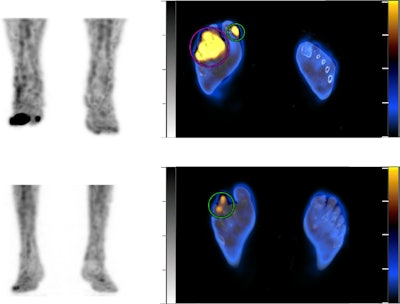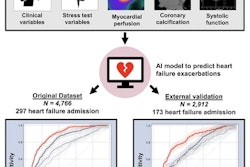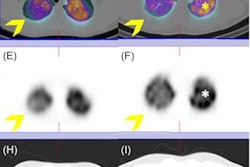Technetium-99m (Tc-99m) white blood cell SPECT/CT imaging may be useful for identifying diabetic patients at risk of amputations due to foot infections, according to a study published April 22 in Scientific Reports.
Researchers at Soonchunhyang University in Seoul, South Korea, found that patients were more likely to undergo amputations when they had high Tc-99m-labeled white blood cell activity at infection sites compared to patients with lower activity. The marker could help identify which patients need more aggressive interventions to avoid amputations, the group suggested.
“There is no efficient imaging tool established yet to predict amputation and guide treatment decisions for patients with [diabetic foot infections],” noted lead author Soo Bin Park, MD, and colleagues.
Foot infections are among the most serious consequences in over half of cases of diabetic foot ulcers, which are frequent complications of diabetes, the authors explained. While Tc-99m-labelled white blood cell (WBC) SPECT has proven useful for the diagnosis of foot infections, the value of hybrid Tc-99m WBC-SPECT/CT remains unexplored in these patients, they noted.
To address this gap in knowledge, the researchers analyzed imaging from patients with suspected diabetic foot infections who underwent Tc-99m WBC-SPECT/CT at their hospital between October 2016 and July 2020. A total of 83 patients (totaling 93 feet) were ultimately included in the study, with amputations performed on 50 limbs (53.8%) of 48 patients within a median follow-up period of 391 days.
The researchers compared clinical and SPECT/CT variables -- history of amputation, numbers of SPECT/CT lesions, and uptake of Tc-99m WBC radiotracer (SUVmax) --between patients who underwent amputations during the follow-up period and those who did not.
 Examples in two patients. (Top) Abnormal leukocyte accumulation was observed in the right 1st to 5th toes, with the radioactive lesions extending to the bone, indicating osteomyelitis (left panel, MIP image; right panel, axial SPECT/CT). Two spherical VOIs were drawn on diabetic foot infections (DFIs) and the highest SUVmax was 4.2 (higher than the cutoff of 1.1) Despite intensive treatment, the infection progressed, leading to the patient undergoing right below knee amputation 43 days after SPECT/CT. (Bottom) Mild focal abnormal leukocyte accumulation was detected in the right 3rd and 4th toes. The lesions were in contact with the bone, which raised a suspicion of osteomyelitis (left panel, MIP image; right panel, axial SPECT/CT). A circular VOI was drawn on DFIs and the SUVmax was 1.0 (lower than the cutoff of 1.1). After 10 weeks of antibiotic treatment, the infection was successfully resolved, and the foot was preserved. Image and caption courtesy of Scientific Reports.
Examples in two patients. (Top) Abnormal leukocyte accumulation was observed in the right 1st to 5th toes, with the radioactive lesions extending to the bone, indicating osteomyelitis (left panel, MIP image; right panel, axial SPECT/CT). Two spherical VOIs were drawn on diabetic foot infections (DFIs) and the highest SUVmax was 4.2 (higher than the cutoff of 1.1) Despite intensive treatment, the infection progressed, leading to the patient undergoing right below knee amputation 43 days after SPECT/CT. (Bottom) Mild focal abnormal leukocyte accumulation was detected in the right 3rd and 4th toes. The lesions were in contact with the bone, which raised a suspicion of osteomyelitis (left panel, MIP image; right panel, axial SPECT/CT). A circular VOI was drawn on DFIs and the SUVmax was 1.0 (lower than the cutoff of 1.1). After 10 weeks of antibiotic treatment, the infection was successfully resolved, and the foot was preserved. Image and caption courtesy of Scientific Reports.
In a quantitative analysis, the amputated feet displayed a higher SUVmax than the nonamputated feet (SUVmax = 3.8 vs. 1.1, p < 0.001), according to the findings. Further, a model that combined clinical variables and SUVmax predicted amputations in 87% of cases, the group found.
“Based on the results of our study, we suggest that SUV in WBC SPECT/CT may be useful for evaluating the severity of infection, in line with ability to predict amputation,” the group wrote.
While the participants in this study represent a real-world diabetic population with foot infections, the authors noted that the results will need to be validated in other studies. Specifically, the cutoff of SUVmax should be validated in individual institutions due to the variability of radiopharmaceutical conditions and performance of SPECT/CT scanners, they wrote.
“Based on our experience, patients with [diabetic foot infections] exhibiting a higher SUVmax should be treated with more aggressive surgical interventions and prolonged antibiotic treatments when compared with patients exhibiting a lower SUVmax,” the group concluded.
The full study is available here.



















